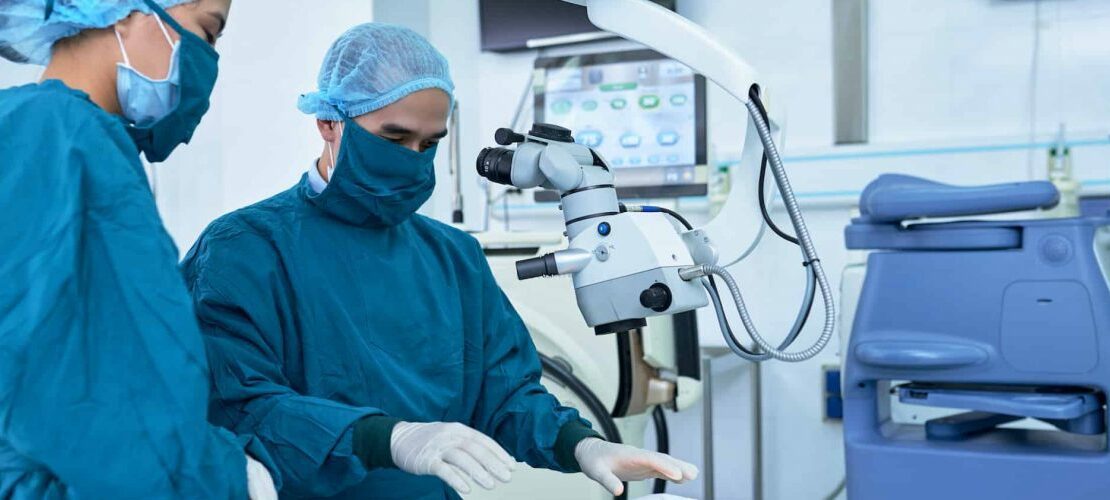- November 20, 2023
- Posted by: American Surgical
- Categories: Blog, Neurosurgery


Minimally invasive surgery (MIS) has revolutionized the field of medicine by offering patients less traumatic procedures, shorter recovery times, and reduced postoperative pain. One critical instrument in the toolkit of minimally invasive surgeons are bipolar forceps. Bipolar forceps are used to coagulate and dissect tissue during surgical procedures, playing a pivotal role in achieving successful outcomes. We explore the significance, advantages, techniques, and considerations associated with bipolar forceps used in minimally invasive surgery.
Significance of Bipolar Forceps in Minimally Invasive Surgery
Bipolar forceps are versatile instruments that have gained immense popularity in MIS due to their ability to control bleeding and minimize tissue damage. These forceps utilize electrical energy to coagulate tissue, providing the surgeon with precise control over the coagulation process. The bipolar configuration, consisting of two prongs, minimizes the risk of unintended electrical current pathways, reducing collateral damage to surrounding structures. This property makes bipolar forceps particularly useful in delicate and complex procedures where preservation of nearby critical structures is paramount.
Advantages of Bipolar Forceps in Minimally Invasive Surgery
- Precision and Control: Bipolar forceps allow surgeons to precisely target specific tissues, vessels, or bleeders for coagulation. This precision is especially crucial in MIS, where limited access and restricted visibility demand accurate tissue manipulation.
- Reduced Bleeding: Hemostasis is vital in any surgical procedure to prevent excessive bleeding. Bipolar forceps coagulate blood vessels effectively, reducing bleeding and allowing for better visualization of the surgical field. This advantage contributes to shorter operation times and decreased blood loss.
- Tissue Preservation: The localized energy delivery of bipolar forceps minimizes damage to adjacent tissues, leading to better tissue preservation and reduced postoperative complications.
- Sealing Blood Vessels: In addition to coagulation, bipolar forceps can be used to seal small blood vessels, preventing oozing and minimizing the need for additional sutures or hemostatic agents.
- Ease of Use: Bipolar forceps are user-friendly instruments, requiring minimal training for effective utilization. Their ergonomic design and straightforward operation make them accessible even to less experienced surgeons.
Techniques for Bipolar Forceps Use in Minimally Invasive Surgery
- Hemostasis and Coagulation: The primary function of bipolar forceps is to achieve hemostasis by coagulating blood vessels. The surgeon applies the forceps to the bleeding vessel, activating the bipolar energy source to coagulate the vessel walls and halt bleeding.
- Tissue Dissection: Bipolar forceps can be used for precise tissue dissection by applying energy to the tissue layers. This technique is particularly useful in separating tissues adhered by natural adhesions or scar tissue.
- Vessel Sealing: For smaller blood vessels that require sealing, the surgeon can gently apply the bipolar forceps to the vessel. The combination of heat and pressure facilitates the sealing process.
- Tumor Resection: In certain procedures, bipolar forceps can assist in tumor resection by minimizing bleeding during tissue excision.
- Adhesion Lysis: In cases of abdominal or pelvic surgeries where adhesions can form, bipolar forceps can be used to carefully lyse these adhesions while minimizing trauma to surrounding tissues.
Bipolar forceps are invaluable tools in the realm of minimally invasive surgery, offering surgeons the ability to achieve precise coagulation, hemostasis, and tissue manipulation. Their advantages, including reduced bleeding, tissue preservation, and ease of use, contribute significantly to improved patient outcomes and shortened recovery times. Proper techniques, careful considerations, and adherence to safety protocols are crucial for harnessing the full potential of bipolar forceps in minimally invasive surgical procedures. As technology continues to evolve, it is likely that bipolar forceps will continue to play a central role in advancing the field of minimally invasive surgery, further enhancing patient care and surgical outcomes.
Leave a Reply
You must be logged in to post a comment.
